Reçeteya Lechon kawali (zikê berazê sorkirî yê tirş)
We Filipinos consider ourselves a people who don’t like wasting anything, especially food. And any dish that’s leftover is spun into another dish ready to be consumed the next mealtime!
One such dish is lechon kawali. In the event that a whole lechon baboy isn’t devoured in a big celebration, you can rest assured that it’ll still last for another day, only as a different meal.
However, you can also cook lechon kawali from scratch and you wouldn’t need an actually roasted pig to start off with.
Continue reading to learn more about the lechon kawali recipe.
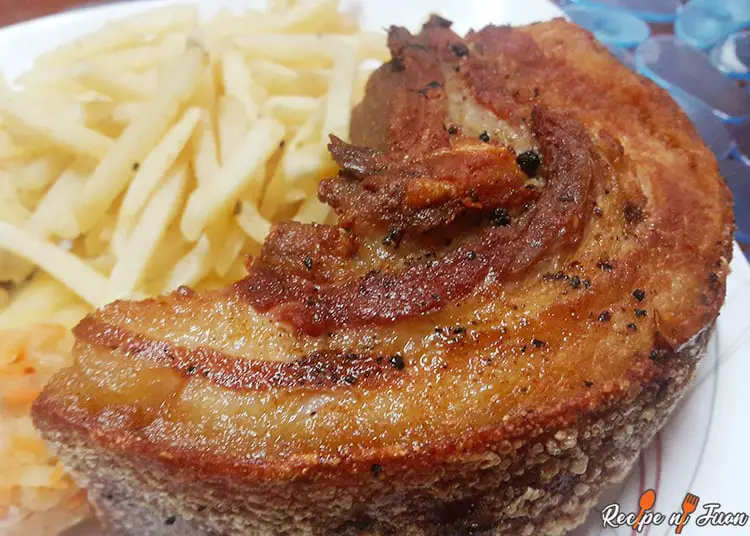

Pirtûka meya nû ya xwarinê bibînin
Rêbazên malbatê yên Bitemybun bi plansazkerê xwarinê û rêbernameya xwarinê ya bêkêmasî.
Bi Kindle Unlimited re belaş biceribîne:
belaş bixwîninDi vê postê de em ê veşêrin:
- 1 Lechon kawali recipe tips and preparation
- 2 Reçeteya Lechon kawali (zikê berazê sorkirî yê tirş)
- 3 Keeping it Safe: Tips for Frying Lechon Kawali
- 4 Flavorful Dipping Sauces to Complement Your Lechon Kawali
- 5 The Best Pork Cut for Lechon Kawali: Picking the Perfect Slab of Meat
- 6 Why isn’t my lechon kawali crispy?
- 7 Boiling Pork: To Do or Not To Do?
- 8 Lechon Belly vs. Lechon Kawali: What’s the Difference?
- 9 Xelasî
Lechon kawali recipe tips and preparation
There are 2 versions of this lechon kawali recipe. One involves using leftover lechon and the other is lechon kawali made from goştê beraz.
This first lechon kawali recipe is very easy to follow. First, heat up oil on a pan, then add the leftover lechon baboy for it to fry.
Piştî qelandin, take off the lechon from the pan and reserve it for later. Now, in a separate pot, saute onion and garlic until translucent, then add the fried lechon.
Then, add flour, sugar, tirşe, and salt and pepper. Let it simmer until the liquid formed by these ingredients is almost evaporated.
An alternative to the flour, sugar, and vinegar combo is just pouring lechon sarsa into the pot after putting in the lechon. Again, adjust the amount of the “sarsa” as you wish.
Herwiha bixwînin: this is the Lechon baboy cebu version that’s equally delicious
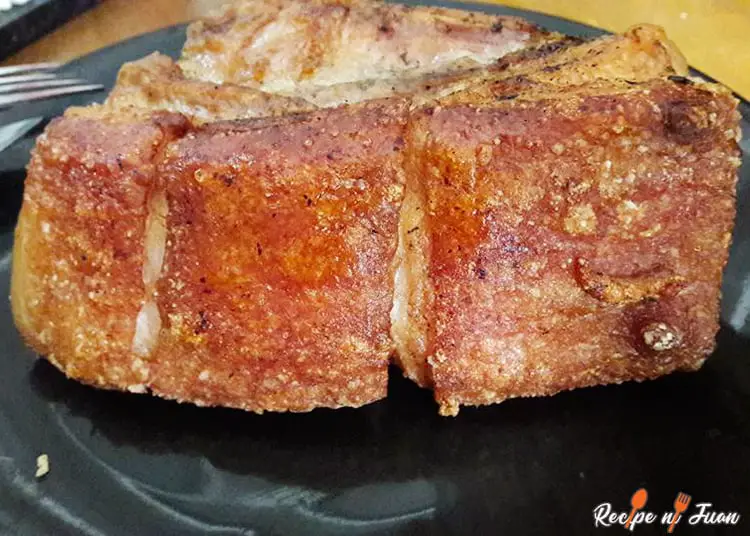
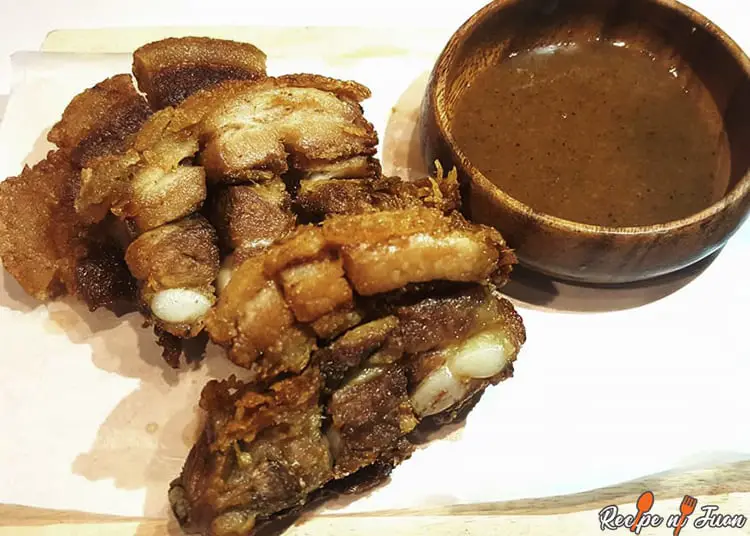
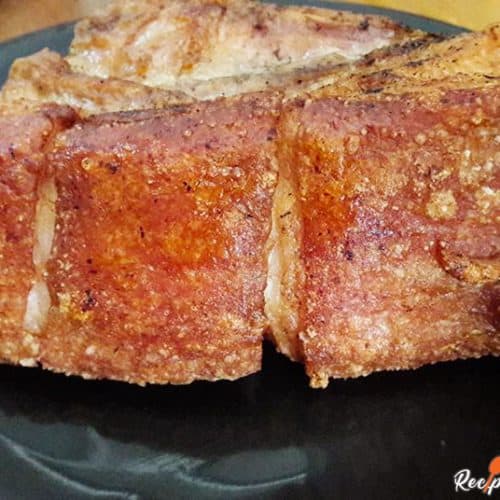
Reçeteya Lechon kawali (zikê berazê sorkirî yê tirş)
Alpîranî
- 2 pounds boneless skin-on pork belly di nîvî de birrîn
- 8 kevir sîr xeniqand
- 2 pelên bayê
- 1 çerm fasûlî reş
- ½ tas soy sauce
- Saltê Kosher
- Canola or peanut oil, for frying
- Rice or cane vinegar, preferably spicy, for dipping
Telîmata
- Place pork belly skin side down in a large pot and add enough water to completely submerge the meat.
- Add garlic, bay leaves, peppercorns, and soy sauce. Bring to a boil over medium-high heat, then lower heat and reduce to a simmer.
- Cover and cook until pork skin can be pierced with a knife with no resistance (about 1 hour).
- Transfer pork to a wire rack set on a rimmed baking sheet and season liberally with salt all over. Refrigerate pork until the skin has completely dried (6 hours or overnight).
- Remove pork from refrigerator and cut into 3/4-inch slices.
- Fill a wok or Dutch oven with at least 4 inches of oil and heat to 375°F over high heat. Working in batches, fry pork until deeply browned and skin has bubbled and crisped (7 to 10 minutes).
- Transfer pork to a paper towel-lined plate and season with salt to taste. Cut pork slices into 1/2-inch pieces.
- Serve immediately with vinegar for dipping.
Kedî
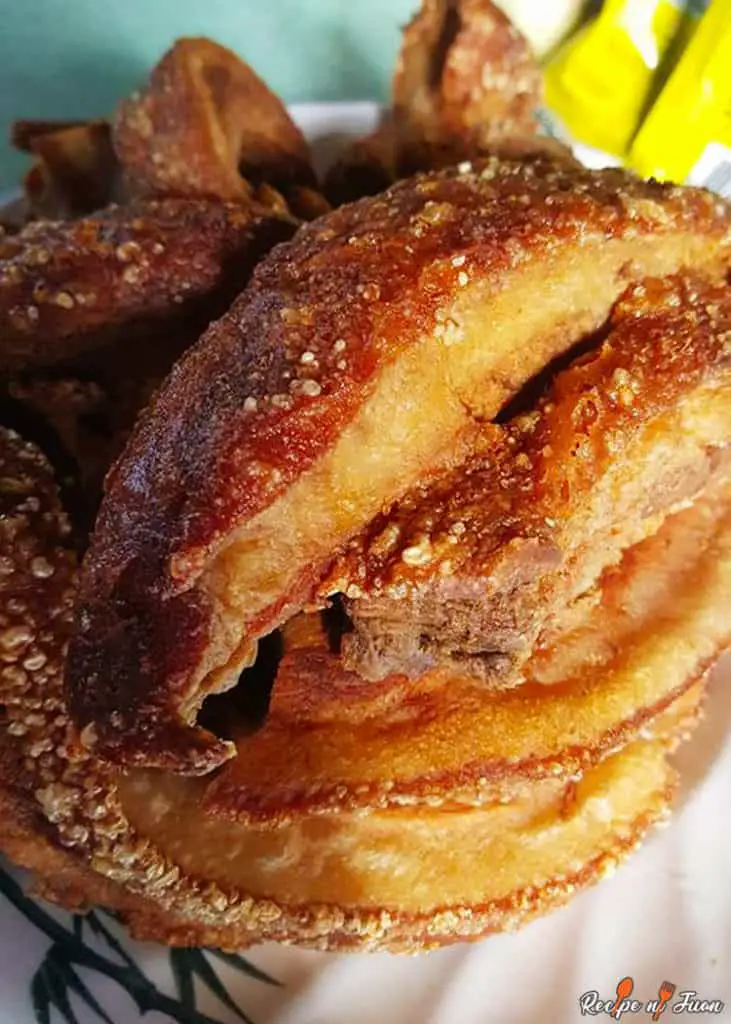
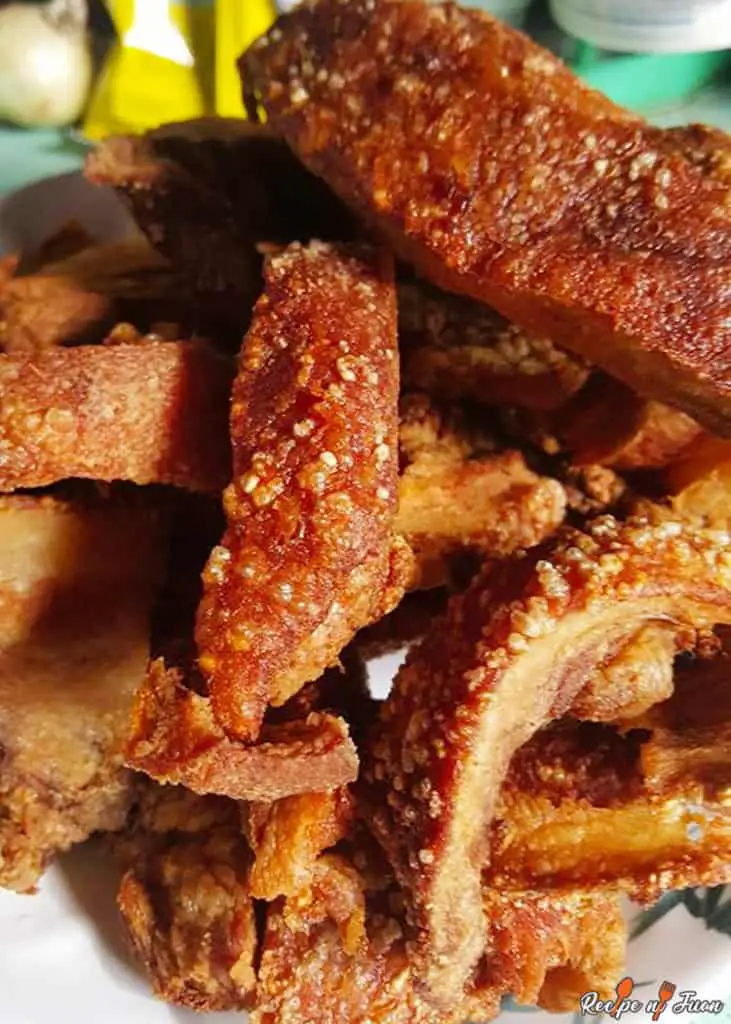
Another version of this lechon kawali recipe involves washing the pork belly and dousing with a combination of pelê defne, salt, and fêkiyên bîbera reş, and refrigerating it overnight.
Ew soy sauce is needed either way to give it that extra bit of saltiness.
Then, you’ll take it out of the refrigerator, heat oil in a pan, and toss the pork belly and deep-fry it. Wait until the pork belly is golden brown.
Once it’s done, take it off of the pan and drain any extra oil.
Again, after this, you have a choice to saute it once more and add Mang Tomas sarsa into it or to serve it already after frying and reserving the lechon sarsa as just a dip.
Keeping it Safe: Tips for Frying Lechon Kawali
Frying lechon kawali can be a delicious and fun experience, but it’s important to keep safety in mind. Here are some tips to keep in mind:
- Always use a deep pot or fryer to prevent oil from splattering.
- Use a splatter screen to further protect yourself from dangerous oil splatters.
- Wear long sleeves and an apron to protect your skin and clothes from hot oil.
- Keep a fire extinguisher handy in case of emergency.
Achieving the Perfect Crisp
Lechon kawali is all about achieving that perfect crisp on the outside while keeping the meat tender and juicy on the inside. Here are some tips to achieve that:
- Use a large pot or fryer to allow enough space for the pork to cook evenly.
- Cut the pork into large slices to prevent excess oil absorption.
- Cover the pot while frying to keep the heat in and allow the pork to cook evenly.
- Allow the pork to cool for a few minutes before serving to prevent burns.
Knowing Your Ingredients
Different recipes call for different ingredients, but here are some things to keep in mind when making lechon kawali:
- Use a pork belly for a richer flavor or a pork shoulder for a leaner option.
- Some recipes call for boiling the pork before frying, while others skip this step. It’s up to personal preference.
- Some people prefer to add broth to the pot while frying for added flavor.
- Sliced potatoes can be added to the pot to absorb excess oil and make the dish healthier.
Cutting and Serving
Once your lechon kawali is cooked to perfection, it’s time to cut and serve. Here are some tips:
- Use a sharp knife to cut the pork into bite-sized pieces.
- Serve with your favorite dipping sauces and condiments.
- Lechon kawali is a great main dish, but it can also be served as a side dish to complement other Filipino foods.
- Leftovers can be stored in the fridge and reheated for a quick and easy meal.
Remember, when it comes to frying lechon kawali, safety is the most important thing. Follow these tips and enjoy your delicious and crispy dish!
Flavorful Dipping Sauces to Complement Your Lechon Kawali
Lechon Kawali is a popular Filipino dish that is typically prepared by frying pork belly until it is crispy on the outside and tender on the inside. While the dish is delicious on its own, it is often served with an array of dipping sauces that add even more flavor to the already tasty dish. In this section, we will explore some of the most common dipping sauces that are served with Lechon Kawali.
Soy-Vinegar Sauce
One of the most popular dipping sauces for Lechon Kawali is the soy-vinegar sauce, also known as “sawsawan.” This sauce is primarily made up of soy sauce and vinegar, with a hint of sweetness from sugar. Here’s a recipe to make your own soy-vinegar sauce:
- 1/4 qedeh sosê soyê
- 1/4 tasek sihik
- 1 tbsp şekir
- 1/4 kasa pîvazê hûrkirî
Mix all the ingredients together and adjust the portions to your liking. Some diners prefer their sauce to be more salty, while others prefer a tangier taste. This sauce is also typically served with other Filipino dishes like Adobo and Sinigang.
Spicy Tomato-Onion Sauce
Another popular dipping sauce for Lechon Kawali is the spicy tomato-onion sauce. This sauce is made up of chopped onions, tomatoes, and chili peppers, with a hint of tanginess from calamansi juice. Here’s a recipe to make your own spicy tomato-onion sauce:
- 1/2 kasa pîvazê hûrkirî
- 1/2 cup chopped tomatoes
- 1/4 cup calamansi juice
- 1 tbsp şekir
- 1 / 4 çermê
Mix all the ingredients together and adjust the portions to your liking. This sauce is perfect for those who love a little bit of heat in their food.
White Vinegar and Garlic Sauce
For those who prefer a simpler dipping sauce, the white vinegar and garlic sauce is a great option. This sauce is made up of white vinegar, chopped garlic, and a pinch of salt. Here’s a recipe to make your own white vinegar and garlic sauce:
- 1/4 qedeh sira sipî
- 2 çîçek kincir, qîçik
- Xwarinê xwê
Mix all the ingredients together and adjust the portions to your liking. This sauce is perfect for those who want to taste the natural flavors of the Lechon Kawali.
Pickled Onion and Tofu Sauce
If you want to add a little bit of texture to your dipping sauce, the pickled onion and tofu sauce is a great option. This sauce is made up of pickled onions, tofu, and a little bit of sugar. Here’s a recipe to make your own pickled onion and tofu sauce:
- 1/2 cup pickled onions
- 1/4 cup soft tofu, mashed
- 1 tbsp şekir
Mix all the ingredients together and adjust the portions to your liking. This sauce is perfect for those who want a little bit of sweetness and tanginess in their dipping sauce.
The Best Pork Cut for Lechon Kawali: Picking the Perfect Slab of Meat
Before we dive into the best pork cut for lechon kawali, let’s quickly describe what this delicious Filipino dish is all about. Lechon kawali is a traditional Filipino dish that translates to “crispy roasted pork belly” in Tagalog. It is a popular dish served during lunch or dinner and is usually accompanied by white rice and dipping sauces.
The Key to Crispy Goodness: Choosing the Right Cut
When making lechon kawali, the goal is to achieve a crispy texture on the outside while keeping the meat tender and juicy on the inside. To achieve this, choosing the right pork cut is crucial. Here are some things to keep in mind when picking the perfect slab of meat:
- The best cut of pork for lechon kawali is pork belly. This is the same cut of meat used for making bacon and is known for its high-fat content, which is essential for achieving a crispy texture.
- If pork belly is not available, you can also use liempo (pork belly with the bones removed) or pork shoulder. However, keep in mind that these cuts have less fat and may not be as crispy.
- When choosing a slab of pork belly, look for one that has an equal distribution of fat and meat. You want to have enough fat to achieve a crispy texture, but not too much that it becomes chewy.
- The ideal thickness for the slab of pork belly is around 1 inch. This allows for alternating layers of fats and meat, which is key to achieving the tastiest lechon kawali.
- Remember to remove any bones or skin from the pork belly before cooking.
Preparing the Pork Cut for Cooking
Now that you’ve got the perfect slab of pork belly, it’s time to prepare it for cooking. Here are some simple steps to follow:
- Boiling: Some recipes call for boiling the pork belly before frying to ensure that it is cooked all the way through. However, this is not necessary and may actually make the meat less crispy. If you do choose to boil the pork belly, make sure to let it cool completely before frying.
- Frying: The most common way of cooking lechon kawali is by deep frying the pork belly in a pan. Make sure to cover the pan to prevent oil splatters and cook until the pork belly is golden brown and crispy.
- Letting it rest: Once the pork belly is cooked, let it rest for a few minutes before slicing it into bite-sized pieces. This allows the juices to redistribute and ensures that the meat stays tender and juicy.
Visual Comparison: Lechon Kawali vs. Lechon Belly
It’s easy to get confused between lechon kawali and lechon belly, as both dishes use pork belly as the main ingredient. However, there are some key differences to keep in mind:
- Lechon belly is a whole roasted pig, while lechon kawali is a dish made from a slab of pork belly.
- Lechon belly is usually served during special occasions and is considered a national dish in the Philippines, while lechon kawali is a more everyday dish.
- Lechon belly is roasted, while lechon kawali is deep-fried.
The Perfect Combination: Serving Lechon Kawali
Lechon kawali is best served hot and crispy, accompanied by white rice and dipping sauces. Here are some typical condiments and dipping sauces to consider:
- Soy sauce and vinegar: This is the most common dipping sauce for lechon kawali and is made by combining soy sauce, vinegar, chopped onions, and chili peppers.
- Mang Tomas: This is a popular Filipino sauce that is commonly used as a dipping sauce for lechon kawali. It is made from liver, vinegar, and sugar.
- Sarsa: This is a sweet and tangy sauce made from banana ketchup, vinegar, and sugar.
Why isn’t my lechon kawali crispy?
Making lechon kawali is a traditional Filipino dish that involves boiling and frying a slab of pork belly or pork cut. The process of making lechon kawali is simple, but it requires patience and attention to detail. Here are some reasons why your lechon kawali might not be crispy:
- The pork cut is too fatty: Fatty pork cuts tend to produce a lot of oil when fried, which can make the lechon kawali soggy instead of crispy. To avoid this, choose a pork cut that has a good mix of fat and meat.
- You didn’t follow the recipe: Lechon kawali recipes usually contain a special mix of ingredients that make the pork crispy. If you didn’t follow the recipe, your lechon kawali might not turn out as crispy as you’d like.
- You boiled the pork for too long: Boiling the pork before frying is an important step in making lechon kawali, but if you boil it for too long, the meat can become too tender and fall apart when fried.
- You didn’t fry the pork long enough: Frying the pork for too short a time can result in a soft and chewy texture instead of crispy. Make sure to fry the pork until it turns golden brown and crispy.
Other factors that affect the crispiness of lechon kawali
Aside from the process, there are other factors that can affect the crispiness of lechon kawali:
- The size of the pork cut: A large pork cut can be hard to fry evenly, resulting in some parts being crispy while others are still soft.
- The type of oil used: Some oils are better for frying than others. Use an oil with a high smoke point, like canola or vegetable oil, to ensure that the pork stays crispy.
- Serving with sauce or topping: Serving lechon kawali with a sauce or topping can make it soggy. If you want to serve it with a sauce, do so on the side.
- Not serving it warm: Lechon kawali is best served warm. If you let it sit for too long, it can lose its crispiness.
Tips for making crispy lechon kawali
Here are some tips to ensure that your lechon kawali turns out crispy:
- Use a pork cut with a good mix of fat and meat.
- Follow the recipe and use the right mix of seasoning and ingredients.
- Boil the pork for just the right amount of time.
- Fry the pork until it turns golden brown and crispy.
- Use an oil with a high smoke point.
- Serve the lechon kawali warm and without any sauce or topping.
Lechon kawali is a favorite main dish in the Philippines and is often served during special occasions like birthdays, BBQs, and holidays. It can also be served as a snack or appetizer, paired with bibingka or skewers like embutido or cheese. Other pork dishes that are popular in the Philippines include humba, caldereta, lechon manok, and pork sisig. Garlic butter and kare-kare are also popular toppings for lechon kawali. If you’re hungry for some crispy lechon kawali, follow these tips and enjoy!
Boiling Pork: To Do or Not To Do?
Boiling pork is a common practice in making Lechon Kawali. Here’s how to do it:
- Choose a good-sized pork shoulder or any pork cut of your choice.
- Cut the pork into equal parts to ensure even cooking.
- Put the pork pieces in a pot and cover them with water.
- Add bay leaves, soy sauce, and ground black pepper to the mixture.
- Bring the mixture to a boil and then lower the heat to let it simmer for 30-45 minutes or until the pork is cooked.
- Remove the boiled pork from the pot and let it cool completely before frying.
What are the advantages and disadvantages of boiling pork before frying?
Boiling pork before frying has its pros and cons. Here are some of them:
Feyda:
- Boiling pork before frying makes the meat tender and juicy.
- It helps remove excess fat from the meat, making it healthier.
- Boiling pork before frying ensures that the pork is cooked all the way through.
dezawantajên:
- Boiling pork before frying takes extra time and effort.
- It can cause the pork to lose some of its natural flavor.
- Boiling pork before frying can cause the meat to become too soft and fall apart.
Ma divê ez goştê beraz berî kelandinê bikelînim?
The answer to this question depends on your personal preference. Some people prefer to boil pork before frying, while others don’t. Here are some things to consider:
- If you want your Lechon Kawali to be super crispy on the outside and juicy on the inside, boiling pork before frying is the ultimate choice.
- If you want to save time and achieve a faster cooking process, you can skip boiling the pork and go straight to frying.
- If you’re careful not to overcook the pork, you can achieve the desired texture and taste without boiling it first.
Lechon Belly vs. Lechon Kawali: What’s the Difference?
Lechon pork belly (full recipe here) is a dish that is made from a portion of the pig’s belly that is filled with different ingredients such as longganisa, tapa, torta, adobo, stewed liver, pochero, bananas, afritada, and tomato sauce. The belly is then rolled and roasted until the skin is crispy and the meat is tender. The dish is often served with a dipping sauce made from vinegar, soy sauce, and chili.
Lechon Kawali
Lechon kawali, on the other hand, is a dish that involves deep-frying pork belly until the skin is crispy and the meat is tender. The pork belly is boiled first to make it tender, then deep-fried until golden brown. The dish is often served with a dipping sauce made from vinegar, soy sauce, and onion.
cudahiyên
The main difference between lechon belly and lechon kawali is the way the pork is cooked. Lechon belly is roasted, while lechon kawali is deep-fried. Other differences include:
- Lechon belly is often filled with different ingredients, while lechon kawali is usually served plain.
- Lechon belly is often served as a centerpiece dish for special occasions, while lechon kawali is a common everyday dish.
- Lechon belly is often served with a tomato-based sauce, while lechon kawali is often served with a vinegar-based sauce.
- Lechon belly is often made from a whole pig, while lechon kawali is made from a portion of the pig’s belly.
Xelasî
So there you have it- everything you need to know about lechon kawali. It’s a delicious Filipino dish made with pork belly, fried until crispy, and served with dipping sauces.
You can’t go wrong with lechon kawali, as long as you follow the tips I’ve given you here and use the right ingredients.
Salamat!
Herwiha bixwînin: Crispy Filipino bagnet recipe, the holy grail for meat lovers
Pirtûka meya nû ya xwarinê bibînin
Rêbazên malbatê yên Bitemybun bi plansazkerê xwarinê û rêbernameya xwarinê ya bêkêmasî.
Bi Kindle Unlimited re belaş biceribîne:
belaş bixwîninJoost Nusselder, damezrînerê Bite My Bun bazarvanek naverokê ye, bav e û hez dike ku xwarina nû bi xwarina Japonî li dilê hewesa xwe biceribîne, û bi hev re bi ekîba xwe re ew ji sala 2016-an vir de gotarên tevnvîsa blogê diafirîne da ku alîkariya xwendevanên dilsoz bike. bi rîsipî û şîretên çêkirina xwarinê.

